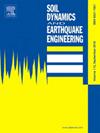Experimental study and numerical simulation of prefabricated ECC energy dissipation wall-RC frame structure
IF 4.2
2区 工程技术
Q1 ENGINEERING, GEOLOGICAL
引用次数: 0
Abstract
Reinforced concrete frame structures exhibit diverse configurations and geometrical complexity, which can lead to inter-story displacement angles and lateral displacements exceeding code-specified thresholds, thus failing to satisfy structural safety requirements. The incorporation of energy dissipation walls within RC frames has been shown to be an effective retrofit technique for enhancing both load-bearing capacity and lateral stiffness in new constructions and existing structures. Engineering Cementitious Composite (ECC), characterized by its distinctive strain-hardening behavior and multi-crack development capability, has been innovatively employed to fabricate prefabricated energy dissipation walls integrated with reinforced concrete (RC) frames, forming a novel composite structural system. Using the OpenSees finite element platform, this study developed a validated numerical model for low shear-span ratio ECC walls through the combined implementation of layered shell elements and NLDKGQ quadrilateral elements, with experimental verification confirming model reliability. Comparative analysis of two prototype configurations with different numbers of energy dissipation walls revealed significant seismic performance enhancements: the EDWF-2 specimen exhibited a 43 % higher bearing capacity than EDWF-1, while systematic evaluation of shear distribution mechanisms highlighted effective cooperative performance between components. Notably, the hybrid system maintains substantial horizontal shear resistance even at a 4 % inter-story displacement angle, with mid-span wall positioning optimizing frame-wall interaction. Performance quantification revealed remarkable improvements in three key seismic indicators—a 110 % increase in ultimate bearing capacity, a 164 % enhancement in lateral stiffness, and a 1.2-fold improvement in cumulative energy dissipation compared to EDWF-1—demonstrating the technical viability of prefabricated ECC energy dissipation wall-RC frame systems for advanced seismic-resistant structural applications.
求助全文
约1分钟内获得全文
求助全文
来源期刊

Soil Dynamics and Earthquake Engineering
工程技术-地球科学综合
CiteScore
7.50
自引率
15.00%
发文量
446
审稿时长
8 months
期刊介绍:
The journal aims to encourage and enhance the role of mechanics and other disciplines as they relate to earthquake engineering by providing opportunities for the publication of the work of applied mathematicians, engineers and other applied scientists involved in solving problems closely related to the field of earthquake engineering and geotechnical earthquake engineering.
Emphasis is placed on new concepts and techniques, but case histories will also be published if they enhance the presentation and understanding of new technical concepts.
 求助内容:
求助内容: 应助结果提醒方式:
应助结果提醒方式:


